12 Health Benefits of Uttanasana & How to Do It?
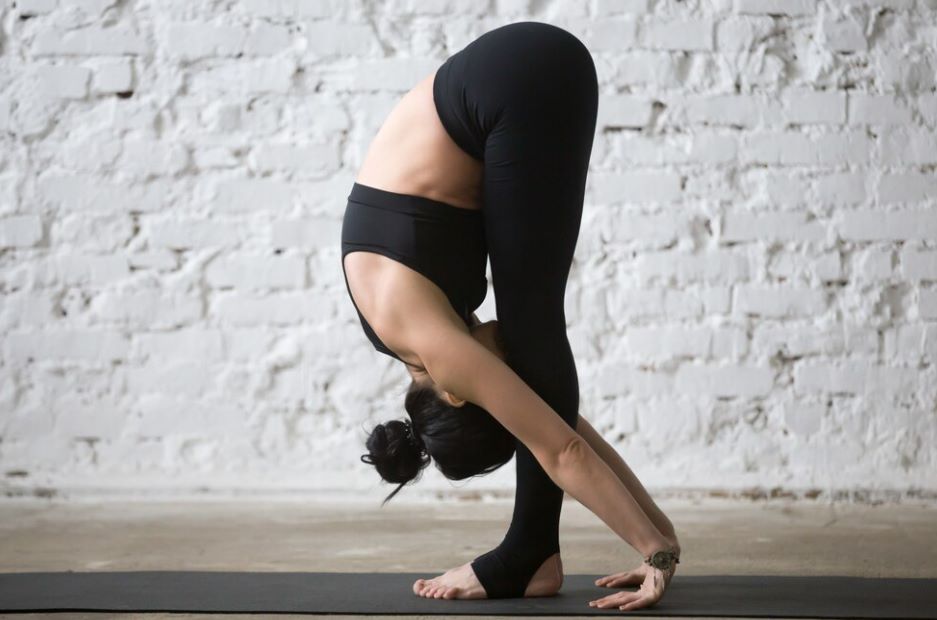
Due to daily life struggles, the body and mind become tired and experience decay. Therefore, it is necessary to heal your body and mind. One of the most natural remedies for healing your body is doing yoga. Different yoga poses help stretch and strengthen your body muscles and allow you to stay active. Uttanasana is one of these poses that has many health benefits.
Do you want to know about the benefits of Uttanasana? Then, keep scrolling through the article to learn everything in detail, like how to perform it, its precautions, steps, etc.

Table of Contents

What is Uttanasana?
In Sanskrit, ‘uttan’ stands for intense stretch, and ‘asana’ stands for a yoga pose. The pose is also called standing forward bend. In this pose, practitioners must touch their feet with their hands by keeping their legs straight.
The pose helps improve blood circulation to the head and rejuvenates the body. It also includes exercises for the abdominal muscles, back, and legs. Find more details below.
How to Perform Uttanasana (Standing Forward Bend)?
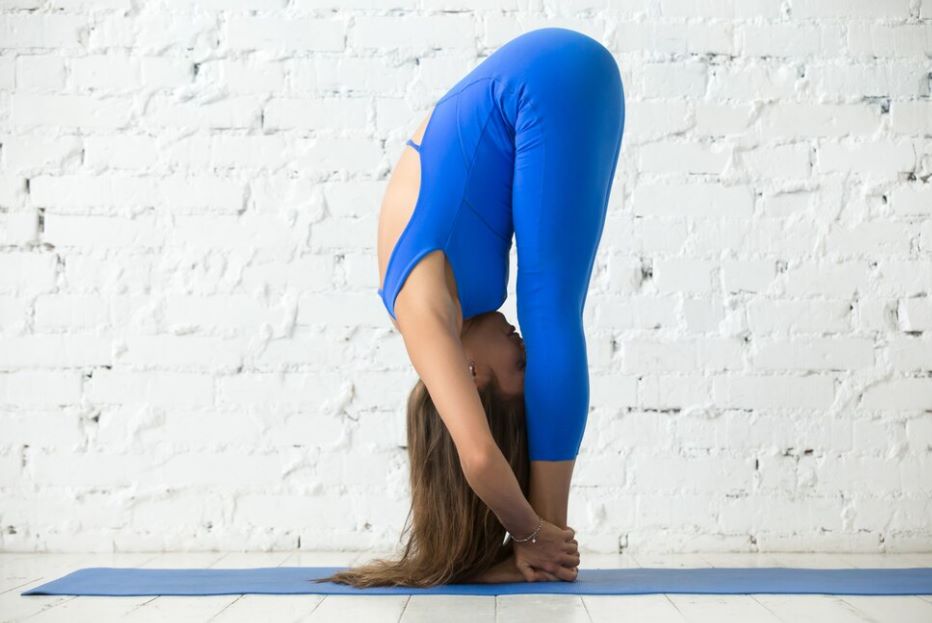
Check out the step-by-step guide to performing the pose to get the maximum of the above advantages:
Step 1: Stand on any surface, outdoor or indoor, with your back and legs straight.
Step 2: Rest your arms by your thighs.
Step 3: Bend down while breathing normally, but do not bend your knees by using your hip joints.
Step 4: Try to touch the ground in this posture.
Step 5: If you are unable to reach the ground, hold your elbows by crossing your forearms until you gain flexibility.
Step 6: If you can, try holding your ankles backwards and touching your head with your knees.
Step 7: After complete flexibility, you can touch your head below your knee and keep your palm on the ground.
Step 8: If you are a beginner, stay in this position for 10 seconds. Experts can perform it for 30 seconds to 1 minute.
Step 9: Keep your breathing regular throughout the process.
Step 10: Slowly inhale and return to the starting position. Relax by exhaling.
12 Health Benefits of Uttanasana
Uttanasana offers numerous advantages for both body and mind. The following are the several health benefits of Uttanasana:
1. Strengthens Leg Muscles
Uttanasana puts pressure on your leg muscles, enhancing their flexibility and performance. Areas that can benefit from It are calves, thighs, knees, hamstrings, and hips.
2. Boosts Blood Circulation
The pose enhances blood flow to areas where it is quite disruptive. As you bend your whole body downwards, a fresh flow of blood enters your brain, helping you rejuvenate your brain cells.
3. Enhances Mental Health
Uttanasana enhances the flow of blood into your brain. Therefore it helps boost mental health. If you regularly practise it, you will be able to reduce the tendency of anxiety, depression, stressful mood, and other mental health issues.
4. Improves Flexibility of Spine
Uttanasana includes full-body bending, which is actually very beneficial for a healthy spine. It enhances the spine’s flexibility and calms the stress points in the neck and back. Therefore, the yoga pose can optimally retain your body's flexibility.
5. Strengthens Abdominal Muscles
One of the biggest benefits of Uttanasana is it effectively activates your core muscles. In addition, it creates pressure on your abdominal muscles and thus makes them stronger. Also, it boosts their functions. So, you can eliminate different abdominal issues by performing this pose.
6. Soothes Body and Mind
In Uttanasana, the brain comes lower to the heart, which is not common. Therefore, it is the responsibility of your heart to pump up the blood to the brain and upper body parts. Thus, while you perform Uttanasana due to the inverted body pose, your heart will be resting. This will soothe your body and mind.
7. Stimulates Organs
Uttanasana gently massages the liver and kidneys, aiding detoxification and improving organ function. This can support overall health and vitality by promoting the elimination of toxins from the body.
8. Relieves Sinus Congestion
The forward fold of Uttanasana helps drain the sinuses, relieving congestion and pressure in the nasal passages. This can provide relief from symptoms of allergies or sinusitis, promoting easier breathing and clearer airways.
9. Improves Posture
Uttanasana strengthens the muscles along the spine and the back, helping to correct poor posture habits. By elongating the spine and encouraging proper alignment, it promotes a more upright and balanced posture.
10. Stretches the Shoulders
Uttanasana stretches the muscles of the shoulders and upper back, relieving tension and tightness. This can be particularly beneficial for individuals who spend long hours sitting at a desk or working on computers, as it counteracts the forward rounding of the shoulders.
11. Promotes Detoxification
Uttanasana stimulates the lymphatic system, which helps to remove toxins and waste products from the body. This can support overall detoxification and purification, leaving practitioners feeling refreshed and revitalised.
12. Enhances Balance
Holding Uttanasana requires focus and stability, which helps to improve balance and coordination. By practising this pose regularly, individuals can develop a greater sense of proprioception and spatial awareness, reducing the risk of falls and injuries.
The Mudras of Uttanasana (Standing Forward Bend Pose)
Uttanasana, or Standing Forward Bend, is a foundational yoga pose that offers many physical and mental benefits. You can incorporate the following mudras, or hand gestures, into Uttanasana to deepen the practice and enhance its effects:
1. Shunya Vayu Mudra
To perform Shunya Vayu Mudra in Uttanasana, fold the index finger and gently place its tip at the base of the thumb while keeping the other fingers extended. Hold this mudra lightly as you deepen into the forward fold.
Benefits of Shunya Vayu Mudra: It has alleviated various ear-related issues such as tinnitus and earaches. Moreover, it enhances mental clarity and promotes inner listening.
2. Varun Mudra
To incorporate Varun Mudra into Uttanasana, gently touch the tips of the thumb and little finger together while extending the other fingers. Maintain this mudra throughout the pose to enhance its benefits.
Benefits of Varun Mudra: Varun Mudra helps balance the body's water elements, regulate fluid balance, and promote hydration. Additionally, it enhances moisture retention and supports kidney function.
Types of Uttanasana
Uttanasana is a foundational yoga pose that comes in various types to suit practitioners of different levels and needs. Here are the two types to find the one that resonates with your body and goals:
1. Baddha Hasta Uttanasana
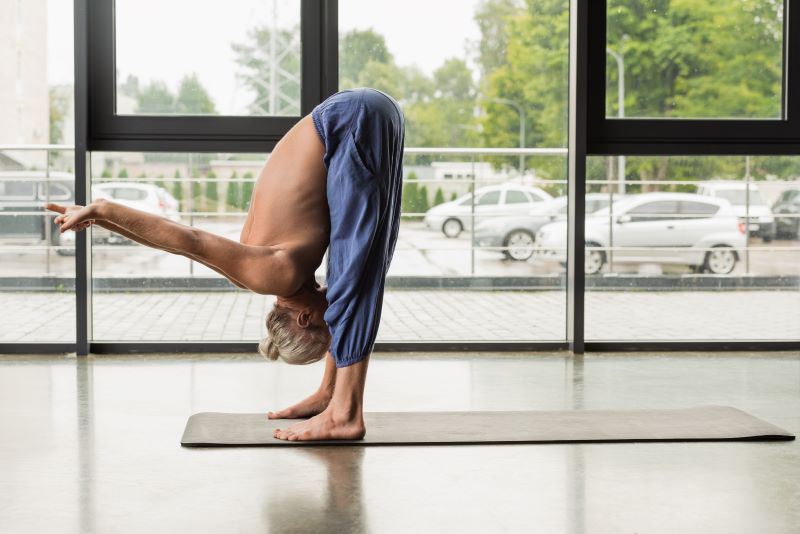
Baddha Hasta Uttanasana starts in Tadasana with feet hip-width apart. Interlace fingers behind the back, straighten arms, and hinge forward from the hips, maintaining a long spine. Feel the stretch in the shoulders, chest, and hamstrings. Release hands to return to standing.
2. Ardha Uttanasana
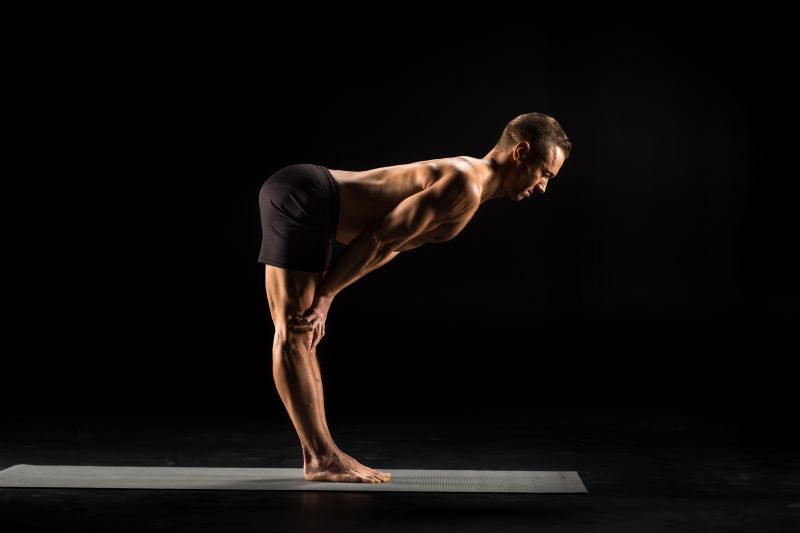
Ardha Uttanasana begins in Tadasana with hands on hips. Hinge forward from hips, keeping spine flat and chest open. Maintain slight knee bend and engage thighs. Feel the stretch in the hamstrings and spine. Return to standing with a flat back.
Things to Know Before Doing Uttanasana Yoga
Before you embark on your Uttanasana practice, it's crucial to understand some essential factors that can enhance your experience and ensure a safe and effective session.
- Find a Quiet Space: Discover a serene area free from distractions and noise to allow for focused attention on your practice. Minimise disturbances to fully immerse yourself in the pose and your breath.
- Prepare Your Yoga Props: Equip yourself with a comfortable yoga mat to provide stability and support during Uttanasana. Consider elevating your hips with a cushion or folded blanket, especially if flexibility is challenging.
- Choose Comfortable Attire: Opt for loose-fitting clothing that allows for unrestricted movement without constriction. Avoid tight attire that restricts breathing or hinders fluid movement while transitioning into and holding Uttanasana.
- Practise on an Empty Stomach: Engage in Uttanasana with a light stomach, ideally a few hours after your meal. This ensures optimal comfort during practice and prevents any discomfort or unease caused by a full stomach.
- Warm-Up Your Body: Prioritize warming up your body with gentle stretches targeting the hips, knees, and ankles before attempting Uttanasana. This prepares the muscles and joints, making the pose more accessible and reducing injury risk.
- Stay Hydrated, but Mindfully: Maintain hydration throughout your practice, but avoid excessive water intake just before starting. Overhydration may lead to frequent breaks during practice, disrupting your flow and focus.
- Focus on Conscious Breathing: Cultivate awareness of your breath from the outset of your practice. Deep, mindful breaths promote relaxation and concentration, enhancing your ability to sustain Uttanasana with ease and presence.
How Long to Hold Uttanasana Pose?
The duration of time one should spend in Uttanasana can vary based on individual flexibility, experience level, and comfort. Here's a general guideline for practitioners at different levels:
- Beginner Practitioners: Start by holding Uttanasana for 30-60 seconds. Gradually increase the duration as you build strength and flexibility.
- Intermediate Practitioners: Hold Uttanasana for 1-2 minutes, focusing on maintaining proper alignment and steady breathing.
- Advanced Practitioners: Hold Uttanasana for 1-5 minutes or longer, depending on individual comfort and stamina. Focus on maintaining the pose with mindfulness.
Risks of Overdoing Uttanasana
While Uttanasana offers numerous benefits when practised mindfully, overdoing this yoga pose can lead to potential risks and complications, such as:
- Strain on Lower Back: Overdoing Uttanasana can put excessive strain on the lower back, especially if performed with improper alignment or without a proper warm-up. Over time, this may lead to discomfort, muscle stiffness, or even lower back injuries.
- Risk of Hamstring Injury: Excessive forward bending in Uttanasana can increase the risk of hamstring strain or injury. Pushing too hard to reach the floor may cause overstretching or tearing of the hamstring muscles, resulting in pain.
- Pressure on Knees and Ankles: Intense forward folding in Uttanasana can exert pressure on the knees and ankles, mainly if the pose is held for an extended period or performed with locked knees.
- Worsening of Spinal Conditions: Individuals with spinal conditions such as herniated discs or sciatica should exercise caution when practising Uttanasana. Overdoing the pose can exacerbate these conditions.
- Increased Risk of Dizziness or Vertigo: Overdoing Uttanasana, especially if performed too quickly or with sudden movements, can disrupt blood circulation and lead to feelings of dizziness or vertigo.
- Potential for Muscle Cramps: Holding Uttanasana for an excessive duration or pushing beyond one's limits may increase the likelihood of experiencing muscle cramps, particularly in the calves, hamstrings, or feet.
- Impact on Digestive System: Overdoing Uttanasana on a full stomach or repeatedly compressing the abdomen in deep forward folds may disrupt digestion and lead to discomfort or digestive issues such as bloating, gas, or indigestion.
Important Tips for Practising Uttanasana
Though Uttanasana seems very easy in appearance, it involves difficult muscle movement. Therefore, doing it without knowledge may result in unnecessary pain and cramps. So, you can follow the below-mentioned tips to perform Uttanasana properly:
- Ask Assistance for the First Time: If you are a beginner, you should seek help from a knowledgeable person or a trainer to learn about the pose. Otherwise, you may practise the wrong posture or force your body unnecessarily.
- Do Not Outstretch: Outstretching your body while performing Uttanasana may lead to severe consequences, such as herniation and muscle pain. Therefore, become a pro of Uttanasana first, and force your body until then.
- Practise Without Distraction: Uttanasana can soothe your body and mind optimally if you practise it by maintaining proper guidelines. It will help if you practise this pose in a peaceful atmosphere.
- Maintain Consistency: Do not leave long gaps between sessions of Uttanasana. Otherwise, you may not get the desired benefits.
What are the Precautions and Contraindications of Uttanasana?
As a beginner, you should be extra cautious while performing Uttanasana. Some warnings have been mentioned below:
Do not have any meal before 4 to 6 hours of practising Uttanasana.
Abstain from performing Uttanasana if you are a patient with Sciatica or Glaucoma.
Do not practise Uttanasana if you are pregnant.
Avoid practising this pose if you have leg or back pain.
Do not perform this posture with injury.
Avoid performing Uttanasana if you are experiencing severe anxiety and stress.
Who Should Avoid Doing Uttanasana?
While Uttanasana offers numerous benefits for many practitioners, there are certain individuals who should exercise caution or avoid this yoga pose altogether, including:
- Pregnant Individuals: Pregnant individuals, especially those in the second and third trimesters, should avoid Uttanasana. The deep forward fold can compress the abdomen and pose a risk to both the parent and baby.
- Individuals with Back Injuries: Those with acute or chronic back injuries, such as herniated discs or severe spinal conditions, should avoid Uttanasana or practise it under the guidance of a qualified yoga instructor.
- Severe Knee or Ankle Problems: Individuals with severe knee or ankle problems, such as recent injuries, ligament tears, or chronic pain conditions, should avoid Uttanasana or modify the pose as needed.
- High Blood Pressure: Those with uncontrolled high blood pressure should avoid Uttanasana, especially when holding the pose for an extended period. The inverted position of the head below the heart can temporarily increase blood pressure.
- Osteoporosis or Bone Density Issues: Those with osteoporosis or low bone density should approach Uttanasana cautiously or avoid it altogether. The forward fold can place stress on the spine and bones.
- Recent Abdominal Surgery: Individuals who have undergone recent abdominal surgery should avoid Uttanasana until they have fully healed and received clearance from their healthcare provider.
What are the Easy Modifications of Uttanasana?
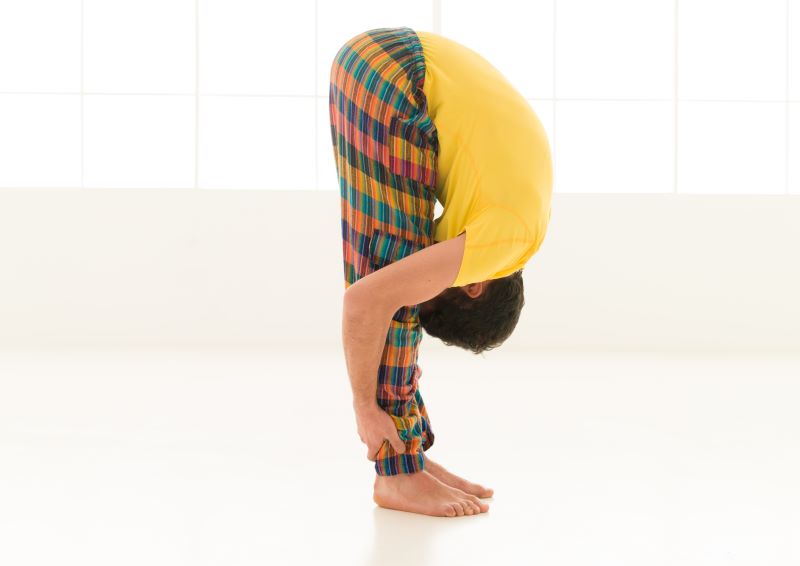
If you face issues performing Uttanasana, you can opt for some modifications. These are as follows:
- Bend Your Knees: You can not bend your knees in Uttanasana. However, beginners can start practising by bending their knees for ease.
- Practise by Facing a Wall: If you notice that you are not able to keep your body balance while performing the pose, you should face a wall for support. For example, you can rest up your back portion to the wall and touch the back of your ankles.
- Take Help From Yoga Blocks: If you find it difficult to place your feet, keep a block between your legs for support.
- Use a Soft Surface: Initially, you may face pressure at your feet, so you can put something soft like a blanket or yoga mat to release the pressure.
- Perform it Halfway: If you find bending your whole body at once difficult, try performing it halfway. Keep it slow and steady to attain the maximum benefit without harming your body parts.
- Take Help of Chair: In the initial days, you can place a chair, put a cushion on it, and place your bent head on it. This will help control blood flow to the head and reduce the chances of sudden pressure.
I hope you have gained comprehensive ideas on the benefits of Uttanasana and its precautions. Therefore, if you are thinking of starting your journey with yoga, you can definitely try this pose and consider this guide to perform it safely.













